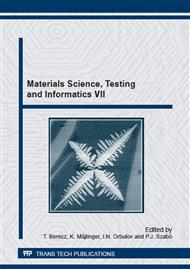[1]
B.C. Muddugangadhar, G.S. Amarnath, S. Tripathi, S. Dikshit, Biomaterials for dental implants, International Journal of Oral Implantology and Clinical Research 2 (2011) 13-24.
DOI: 10.5005/jp-journals-10012-1030
Google Scholar
[2]
Information on http: /www. britannica. com/EBchecked/topic/597135/titanium-Ti 27. 01. (2014).
Google Scholar
[3]
M. McCracken, Dental Implant Materials: Commercially: Pure Titanium and Titanium Alloys, Journal of Prosthodontics 8 (1999) 40-43.
DOI: 10.1111/j.1532-849x.1999.tb00006.x
Google Scholar
[4]
ADA Council on scientific affairs, Titanium applications in dentistry, Journal of the Dental Association 134 (2003) 347-349.
Google Scholar
[5]
K. Subramani, R.T. Mathew: Emerging Nanotechnologies in Dentistry, Chapter 6: Titanium Surface Modification Techniques for Dental Implants - From Microscale to Nanoscale, William Andrew Publishing, ISBN: 978-1-4557-7862-1 2011, pp.85-102.
DOI: 10.1016/b978-1-4557-7862-1.00006-7
Google Scholar
[6]
S. Szmukler-Moncler, T. Testori, J. P. Bernard: Etched Implants: A Comparative Surface Analysis of Four Implant Systems, J Biomed Mater Res Part B: Appl Biomater 69 (2004) 46–57.
DOI: 10.1002/jbm.b.20021
Google Scholar
[7]
S. Szmukler-Moncler, D. Perrin, V. Ahossi et al, Biological properties of acid etched titanium implants: effect of sandblasting on bone anchorage, J. Biomed. Mater. Res. 68 (2004) 149-159.
DOI: 10.1002/jbm.b.20003
Google Scholar
[8]
S. Anil, P.S. Anand, H. Alghamdi, J.A. Jansen, Dental Implant Surface Enhancement and Osseointegration, Implant Dentistry - A Rapidly Evolving Practice, InTech (2011) ISBN: 978-953-307-658-4.
DOI: 10.5772/16475
Google Scholar
[9]
C.N. Elias: Titanium dental implant surfaces, Revista Matéria 15 (2010) 138-142.
DOI: 10.1590/s1517-70762010000200008
Google Scholar
[10]
C. N. Elias, Y. Oshida, J. H. C. Lima, C. A. Muller, Relationship between surface properties (roughness, wettability and morphology) of titanium and dental implant removal torque, Journal of the Mechanical Behavior of Biomedical Materials 1 (2008).
DOI: 10.1016/j.jmbbm.2007.12.002
Google Scholar
[11]
G. Juodzbalys, M. Sapragoniene, A. Wennerberg, New Acid Etched Titanium Dental Implant Surface, Stomatologija, Baltic Dental and Maxillofacial Journal 5 (2003) 101-105.
Google Scholar
[12]
H. Garg, G. Bedi, A. Gargmost, Implant Surface Modifications: A Review, Journal of Clinical and Diagnostic Research 6 (2012) 319-324.
Google Scholar
[13]
G. Orsini, B. Assenza, A. Scarano, M. Piatteli, A. Piatteli, Surface analysis of machined versus sand blasted and acid etched Ti implants, Int. J. Oral Maxillofac. Implants 15 (2000) 779-784.
Google Scholar
[14]
S.A. Cho, K.T. Park, The removal torque of titanium screw inserted in rabbit tibia treated by dual acid etching, Biomaterials 24 (2003) 3611–3617.
DOI: 10.1016/s0142-9612(03)00218-7
Google Scholar
[15]
L. Le Gu´ehennec, A. Soueidan, P. Layrolle , Y. Amouriq, Surface treatments of titanium dental implants for rapid osseointegration, Dental Materials 23 (2007) 844-854.
DOI: 10.1016/j.dental.2006.06.025
Google Scholar
[16]
C.Y. Guo, A.T.H. Tang, J.P. Matinlinna, Insights into surface treatment methods of titanium dental implants, Journal of Adhesion Science and Technology 26 (2012) 189-205.
DOI: 10.1163/016942411x569390
Google Scholar
[17]
M. Wong, J. Eulenberger, R. Schenk, E. Hunziker, Effect of surface topology on the osseointegration of implant materials in trabecular bone, J. Biomed. Mater. Res. 29 (1995) 1567–1575.
DOI: 10.1002/jbm.820291213
Google Scholar
[18]
R. B. Parekh, O. Shetty, R. Tabassum, Surface modifications for endosseous dental implants, International Journal of Oral Implantology and Clinical Research, 3 (2012) 116-121.
DOI: 10.5005/jp-journals-10012-1078
Google Scholar
[19]
J.E. Ellingsen, Pre-treatment of titanium implants with fluoride improves their retention in bone, Journal of Materials Science: Materials in Medicine 6 (1995) 749–758.
DOI: 10.1007/bf00134312
Google Scholar
[20]
J.E. Ellingsen, C.B. Johansson, A. Wennerberg, A. Holmen, Improved retention and bone-to-implant contact with fluoride-modified titanium implants, International Journal of Oral and Maxillofacial Implants 19 (2004) 659–66.
Google Scholar
[21]
B. Taylor, E. Weidmann, Struers Application Notes: Metallographic preparation of titanium (2008).
Google Scholar


